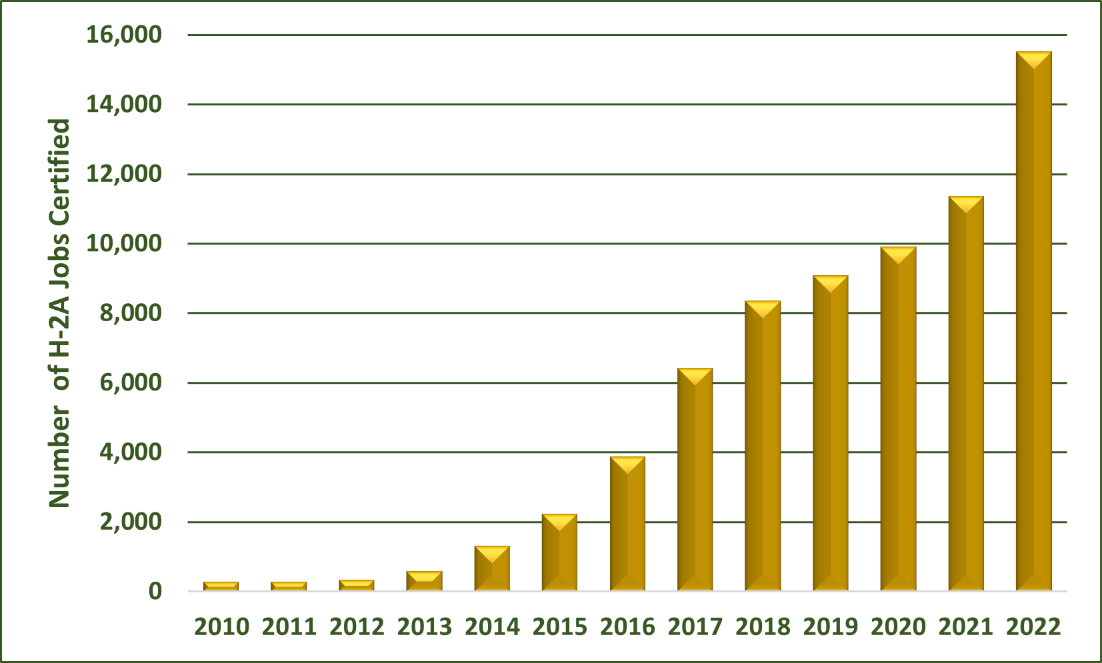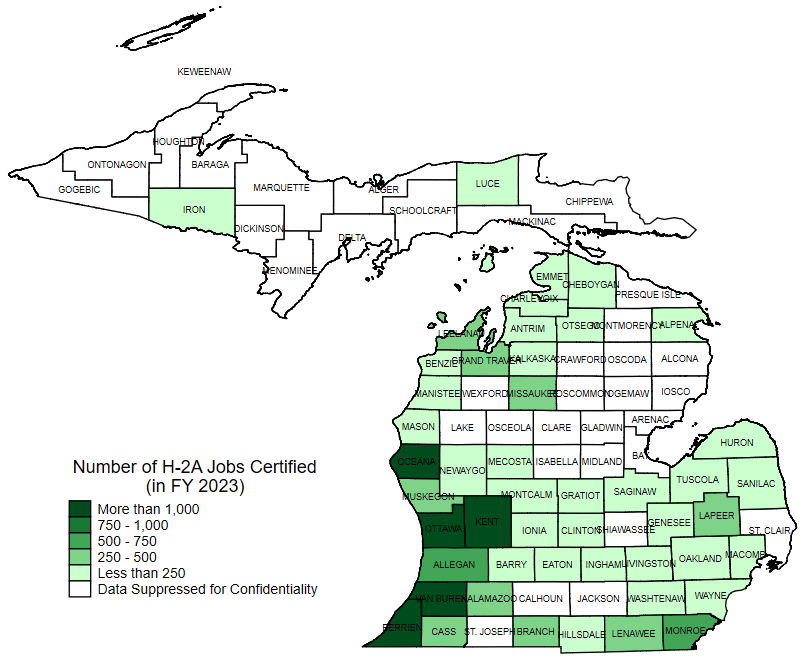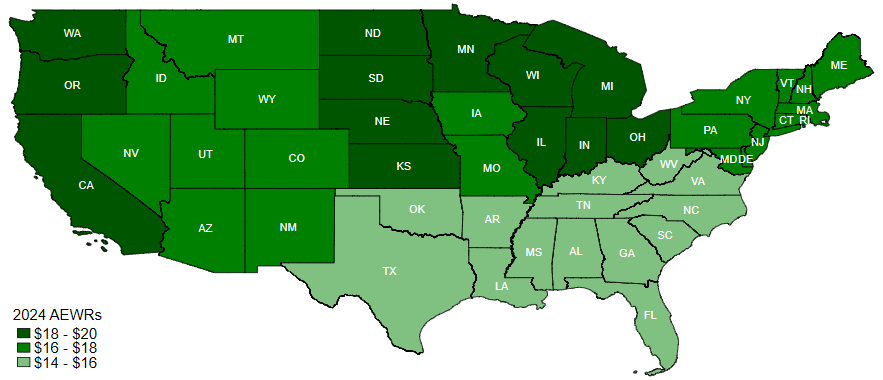The Farm Workforce Modernization Act and the H-2A Visa Program
What will happen if the Farm Workforce Modernization Act (FWMA) passes?

In 2023, the Farm Workforce Modernization Act (FWMA) was reintroduced in the United States (U.S.) House of Representatives after failing to pass through the Senate in 2022. If passed, the Act would make a number of reforms to the existing H-2A agricultural visa program, which allows agricultural employers to hire foreign workers on a temporary basis when there is a shortage of farm labor.
The H-2 program was initiated by Congress in 1952 with the passage of the Immigration and Nationality Act. The H-2 program allowed foreign laborers to work in the U.S. on a temporary basis to perform “low-skilled labor” in both the agricultural and non-agricultural sectors. When the Immigration Reform and Control Act was passed in 1986, the H-2 program was divided into the H-2A program for agricultural workers and the H-2B program for non-agricultural workers. The intent of the H-2A program is to fill labor shortages in US agriculture while making sure that U.S.-based farmworkers are not negatively impacted. The H-2A program historically comprised only a small proportion of the U.S. farm labor force, but over the past decade, use of the H-2A program has expanded rapidly.
Recent empirical and anecdotal evidence suggests that the farm labor supply is becoming smaller due to a number of political, economic and demographic factors. This trend has led to labor shortages for some regions of the U.S. and has stimulated use of the H-2A program. Between fiscal years 2010 and 2022, the number of Michigan H-2A jobs certified by the U.S. government increased steadily from 300 to 15,500 (see Figure 1).
Figure 1: Michigan H-2A Jobs Certified FY2010-FY2022

Most of Michigan’s H-2A workers are employed on the southwestern side of the lower peninsula (see Figure 2). Kent County had 2,500 jobs certified, followed by Oceana County (1,700), Ottawa County (1,400), Van Buren County (1,300) and Berrien County (1,300).
Figure 2. Michigan H-2A Employment in Fiscal Year 2023

Foreign workers have served as the backbone of the U.S agricultural labor force for many decades, but immigrant workers have often been viewed as an economic threat to the domestic workforce. In order to mitigate adverse effects from the employment of temporary foreign workers in the agricultural sector, H-2A workers (and the U.S. workers who work for H-2A employers in similar roles) must be paid an amount no less than a wage called the Adverse Effect Wage Rate (AEWR). H-2A workers must also be paid the highest of the state or federal minimum wage, the local prevailing wage or piece rate, an agreed-upon wage determined by a collective-bargaining process, or the AEWR. The AEWR reflects a measure of the average gross hourly earnings of US farm workers in the region. The AEWRs for 2024 ranged from $14.53 in the southeastern part of the country to $19.75 for California (see Figure 3). Michigan’s 2024 AEWR is $18.50. For more information on the AEWRs, refer to What are Adverse Effect Wage Rates?
Figure 3: 2024 Adverse Effect Wage Rates

The FWMA was drafted with the intention of stabilizing the agricultural sector in response to the ongoing labor-availability problems experienced by U.S. farm employers. The Act has three main functions, which fall under three titles.
Title 1
The goal of Title 1 is to ensure that a domestic agricultural workforce is available. Title 1 will allow undocumented farmworkers to seek and obtain Certified Agricultural Worker (CAW) status, which is a temporary legal status for workers who have been engaged in agricultural work for at least 180 days during the previous 2 years. If passed, CAW status can be renewed every year if workers continue to engage in agricultural work for at least 100 days per year. Workers will not be required to do anything else to keep their legal status, but they could earn a green card if they pay a $1,000 fine and continue to engage in agricultural work for (i) four more years if they have done at least 10 years of agricultural work in the US or (ii) eight more years if they have done less than 10 years of agricultural work in the US
Title 2
The goal of Title 2 is to ensure there is an agricultural workforce in the future. Title 2 will reform the H-2A visa program to provide more flexibility for agricultural employers and protections for workers. Title 2 will streamline the H-2A application process by providing an electronic platform for H-2A visa application filing, which will also allow employers to file one application for seasonal labor needs that are staggered throughout the year. It will also allow farmers to post job advertisements electronically and reduce hiring and recruiting costs by extending the length of the visa to 3 years.
In addition, Title 2 would revise the method for calculating the AEWRs by using occupation specific AEWRs instead of a single AEWR for all workers. Similar provisions were implemented in a rule the U.S Department of Labor implemented in 2023 for higher-skilled farm occupations. Year-over-year changes in the AEWR would be limited to a maximum of a 1.5% decline or a 3.25% increase until the year 2030.
Under Title 2, 20,000 H-2A workers could work year-round for up to 3 years throughout the U.S. This will permit dairy and other year-round farmers to have access to legal foreign workers. The cap on year-round workers will be adjusted each year based on labor metrics or an emergency determination if there are significant labor shortages. It will also permit H-2A workers to apply for a green card after 10 years of work in the U.S.
Title 2 will also address ongoing housing shortages by allocating $1 billion to rehabilitate aged out housing, increasing funding for rural housing loan and rental assistance programs, and providing subsidies to property owners who house H-2A workers.
Title 3
Title 3 will implement a mandatory e-verify system for all agricultural employment, which will be phased in over time and ensure that farm employees are legally authorized to work in the U.S.
In some cases, the AEWR serves as a benchmark for non-H-2A agricultural employers. As such, the 80% to 90% of agricultural workers who the AEWR does not directly affect may be indirectly impacted by it through market pressures. For example, preliminary research findings from a study in progress suggest that higher AEWRs cause the wages of non-H-2A employees to rise. Accordingly, if the FWMA passes and AEWR growth is capped, some domestic farmworkers may realize slower wage growth arising from the effects of AEWR on domestic farm wages.
Additional Resources
Bipartisan House Members Reintroduce the Farm Workforce Modernization Act of 2023
Farm Workforce Modernization Act



 Print
Print Email
Email